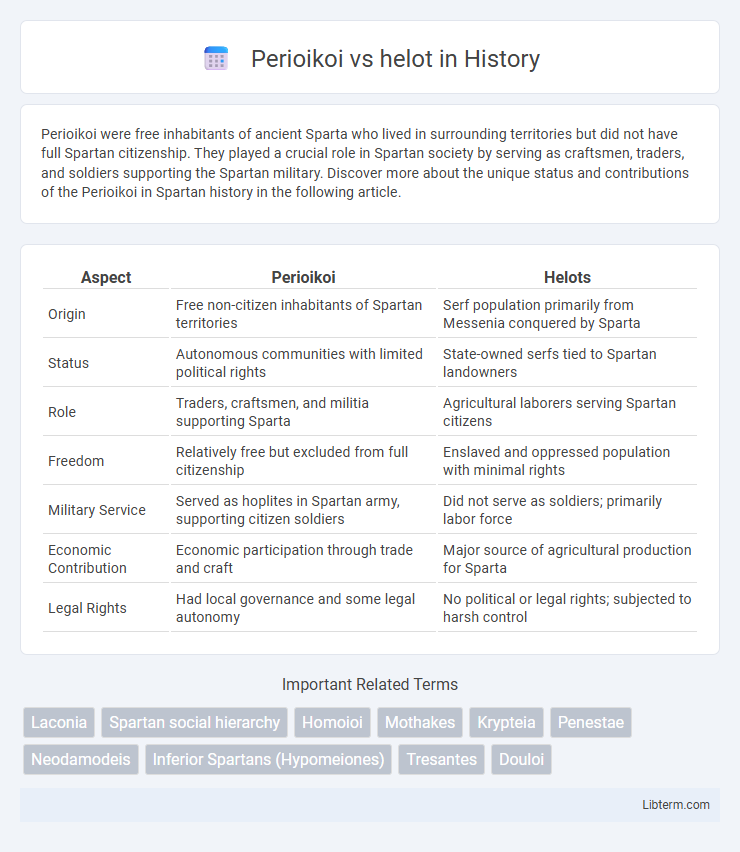Perioikoi were free inhabitants of ancient Sparta who lived in surrounding territories but did not have full Spartan citizenship. They played a crucial role in Spartan society by serving as craftsmen, traders, and soldiers supporting the Spartan military. Discover more about the unique status and contributions of the Perioikoi in Spartan history in the following article.
Table of Comparison
| Aspect | Perioikoi | Helots |
|---|---|---|
| Origin | Free non-citizen inhabitants of Spartan territories | Serf population primarily from Messenia conquered by Sparta |
| Status | Autonomous communities with limited political rights | State-owned serfs tied to Spartan landowners |
| Role | Traders, craftsmen, and militia supporting Sparta | Agricultural laborers serving Spartan citizens |
| Freedom | Relatively free but excluded from full citizenship | Enslaved and oppressed population with minimal rights |
| Military Service | Served as hoplites in Spartan army, supporting citizen soldiers | Did not serve as soldiers; primarily labor force |
| Economic Contribution | Economic participation through trade and craft | Major source of agricultural production for Sparta |
| Legal Rights | Had local governance and some legal autonomy | No political or legal rights; subjected to harsh control |
Introduction to Perioikoi and Helots
Perioikoi were free, non-citizen inhabitants of ancient Sparta who managed local commerce and craftsmanship while serving as armed soldiers when needed. Helots were state-owned serfs primarily responsible for agricultural labor, bound to the land and subjected to harsh control and oppression by Spartan citizens. Both groups were integral to Spartan society, with Perioikoi sustaining economic activities and Helots ensuring food production.
Historical Background of Sparta
Perioikoi were free, non-citizen inhabitants of Sparta responsible for trade and craftsmanship, distinct from the helots who were state-owned serfs primarily tasked with agriculture and subjected to harsh subjugation. Both groups formed the backbone of Sparta's socio-economic structure during the classical period, with periokoi maintaining autonomous communities while helots were tied to Spartan landowners. This rigid social stratification underpinned Sparta's militaristic society, ensuring Spartan citizens could focus exclusively on military training and governance.
Social Status: Perioikoi vs Helots
Perioikoi in ancient Sparta held an intermediate social status as free inhabitants engaged in commerce and craftsmanship, yet they lacked full political rights. Helots were state-owned serfs primarily responsible for agricultural labor, subjected to harsh control and lacking personal freedom. The stark contrast in social status placed Perioikoi above Helots, granting them relative autonomy and economic roles while Helots remained subjugated and exploited.
Roles in Spartan Economy
Perioikoi were free, non-citizen inhabitants of Sparta who managed trade, craftsmanship, and agricultural production, serving as essential contributors to the Spartan economy. Helots were state-owned serfs primarily responsible for farming the land and providing food supplies to support the Spartan military elite. The Perioikoi maintained economic activities beyond agriculture, while helots ensured the agrarian backbone necessary for Spartan sustenance and military focus.
Military Contributions
Perioikoi were free inhabitants of Sparta who contributed significantly as hoplite soldiers in the Spartan army, providing essential military support while retaining some autonomy. Helots, on the other hand, were state-owned serfs primarily tasked with agricultural labor but also occasionally enlisted as auxiliary troops during times of war. The Perioikoi's organized military role contrasted with the helots' more limited and coercive involvement in Sparta's warfare.
Political Rights and Restrictions
Perioikoi in ancient Sparta were free inhabitants with limited political rights, as they could engage in local governance but lacked citizenship and full participation in the Spartan assembly or military elite. Helots were state-owned serfs subjected to severe restrictions, having no political rights and forced to serve Spartan citizens through agricultural labor and tribute. The Perioikoi acted as a middle class with economic roles and minimal political agency, whereas helots were oppressed with virtually no personal freedoms or political influence.
Daily Life and Cultural Differences
Perioikoi, free non-citizen inhabitants of Sparta, engaged in trade, craftsmanship, and served as skilled soldiers, maintaining autonomy in their daily activities while adhering to Spartan laws; their cultural practices incorporated elements of wider Greek traditions. Helots, state-owned serfs, primarily worked as agricultural laborers to sustain the Spartan economy, lived under strict surveillance, and endured harsh treatment with limited personal freedoms, reflecting their oppressed status. Socially, Perioikoi participated in community religious festivals and economic exchanges unlike helots, whose cultural expression was suppressed to prevent rebellion.
Pathways to Freedom or Advancement
Perioikoi, free non-citizen inhabitants of Sparta, maintained limited autonomy and could engage in trade or craft, enabling economic advancement and potential social mobility within Spartan society. Helots, state-owned serfs primarily responsible for agricultural labor, faced severe restrictions and had virtually no pathways to freedom except through rare acts of valor in war or Spartan manumission. The stark contrast in their statuses reflects the rigid social hierarchy of Sparta, where perioikoi possessed more opportunities for advancement compared to the enslaved helot population.
Rebellions and Relations with Spartans
The Perioikoi served as autonomous, free inhabitants surrounding Sparta, maintaining trade and military duties without direct political rights, while helots were an enslaved population primarily tasked with agricultural labor under harsh Spartan control. Helot rebellions were frequent and brutal, with major uprisings such as the Third Messenian War forcing Sparta to implement strict military oversight and harsh punitive measures to suppress revolts. Relations with Spartans differed significantly: Perioikoi had cooperative military alliances and economic interdependence, whereas helots were dominated and oppressed, living under constant threat of violence and systemic subjugation.
Lasting Legacy and Modern Interpretations
The Perioikoi and Helots were crucial social groups in ancient Sparta, with the Perioikoi serving as free, non-citizen inhabitants engaged in trade and craftsmanship, while Helots were state-owned serfs primarily responsible for agriculture. Their distinct roles fostered a rigid social hierarchy that influenced Spartan military efficiency and socioeconomic stability, leaving a lasting legacy on the study of ancient Greek social structures. Modern interpretations emphasize the Helots' resistance and subjugation as early examples of class struggle, shaping contemporary discussions on slavery, oppression, and social stratification in historical contexts.
Perioikoi Infographic

 libterm.com
libterm.com